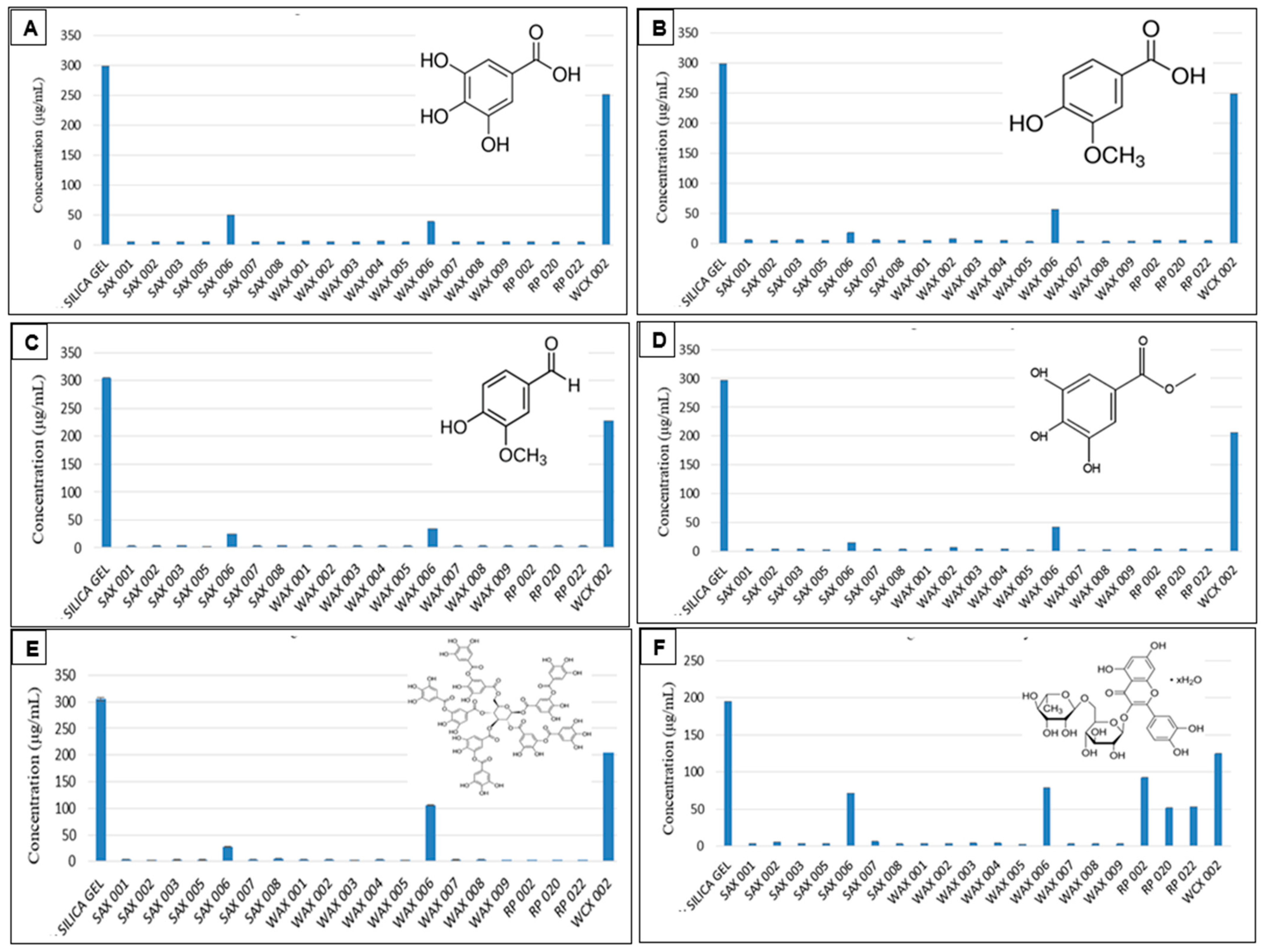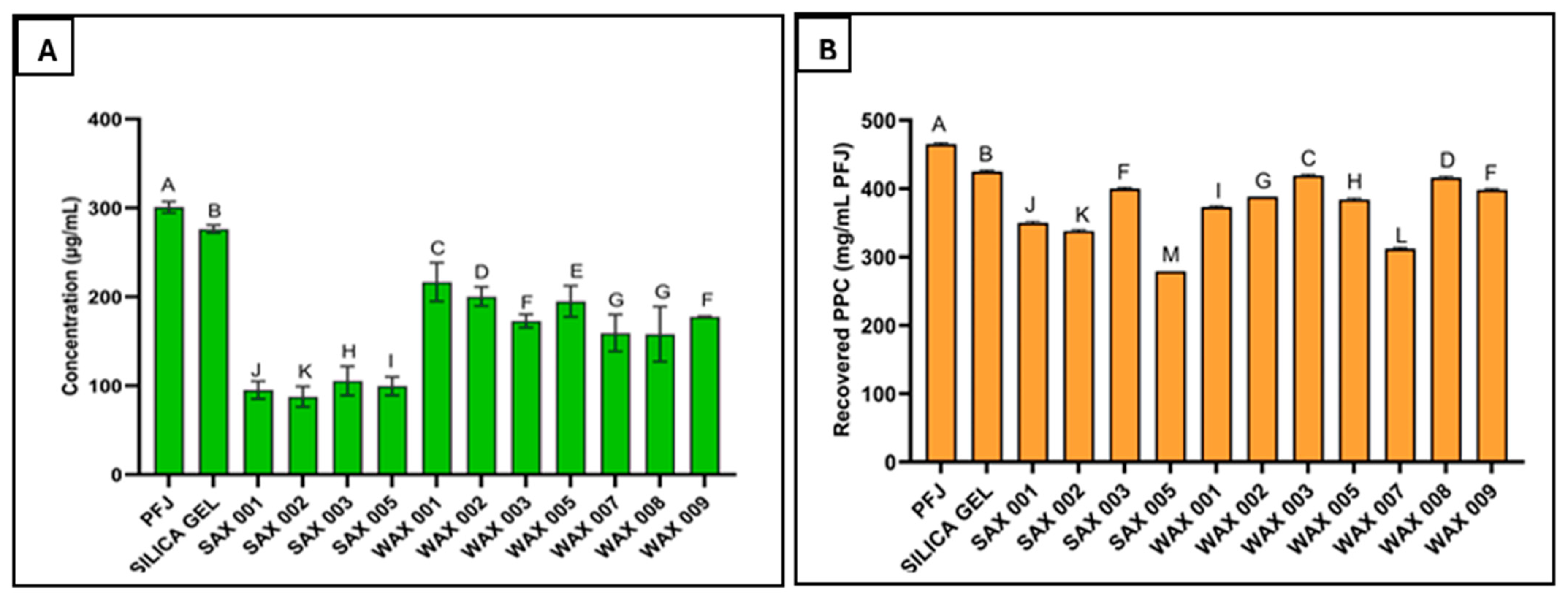Potato Protein Concentrate: Improving Quality Using a More Effective and Sustainable Method †
Abstract
1. Introduction
2. Materials and Methods
2.1. Preliminary Screening of Resins for Phenolic Binding
2.1.1. Dilution and Establishing a Standard Curve
2.1.2. Resin Binding Analysis
2.1.3. Folin-Ciocâlteu Spectrophotometric Method
2.2. Resin Capacity Determination
2.2.1. Gallic Acid Binding, Recovery, and Titration Against Hydrochloric Acid (HCl)
2.2.2. Titration Test of Resins Against HCl
2.3. Removal of Phenolics from PFJ
2.4. Potato Protein Precipitation
2.5. Analysis of the Phenolic Content in Precipitated PPC
2.5.1. Free Phenolic Extraction
2.5.2. Alkaline Extraction of Bound Phenolics
2.5.3. Acidic Extraction of Bound Phenolics
2.5.4. Total Phenolic Content (TPC)
2.6. Data Analysis
3. Results and Discussion
3.1. Preliminary Screening of Resins for Their Binding Towards Phenolics
3.2. Resin Capacity Determination
Gallic Acid Binding, Recovery, and Titration Against HCl
3.3. Removal of Phenolics from PFJ
3.4. Potato Protein Precipitation
3.5. Removal of Phenolics from PPC
3.6. Relationship Between the Total Phenolic Content of the PPC and the Amount of PPC Recovered
4. Conclusions
Author Contributions
Funding
Institutional Review Board Statement
Informed Consent Statement
Data Availability Statement
Acknowledgments
Conflicts of Interest
References
- Bradshaw, J.E.; Ramsay, G. Potato Origin and Production. In Advances in Potato Chemistry and Technology; Elsevier: Amsterdam, The Netherlands, 2009; pp. 1–26. [Google Scholar]
- Devaux, A.; Goffart, J.P.; Kromann, P.; Andrade-Piedra, J.; Polar, V.; Hareau, G. The Potato of the Future: Opportunities and Challenges in Sustainable Agri-food Systems. Potato Res. 2021, 64, 681–720. [Google Scholar] [CrossRef] [PubMed]
- Deußer, H.; Guignard, C.; Hoffmann, L.; Evers, D. Polyphenol and glycoalkaloid contents in potato cultivars grown in Luxembourg. Food Chem. 2012, 135, 2814–2824. [Google Scholar] [CrossRef] [PubMed]
- Burlingame, B.; Mouillé, B.; Charrondière, R. Nutrients, bioactive non-nutrients and anti-nutrients in potatoes. J. Food Compos. Anal. 2009, 22, 494–502. [Google Scholar] [CrossRef]
- ChemAnalyst. Potato Starch Market Analysis: Industry Market Size, Plant Capacity, Production, Operating Efficiency, Demand & Supply Gap, End-User Industries, Sales Channel, Regional Demand, Company Share, Manufacturing Process, 2015–2034. Available online: https://www.chemanalyst.com/industry-report/potato-starch-market-3131 (accessed on 20 February 2025).
- Løkra, S.; Strætkvern, K.O. Industrial Proteins from Potato Juice. A Review. Food 2009, 3, 88–95. [Google Scholar]
- Ralet, M.C.; Guéguen, J. Fractionation of Potato Proteins: Solubility, Thermal Coagulation and Emulsifying Properties. LWT-Food Sci. Technol. 2000, 33, 380–387. [Google Scholar] [CrossRef]
- Hertzler, S.R.; Lieblein-Boff, J.C.; Weiler, M.; Allgeier, C. Plant Proteins: Assessing Their Nutritional Quality and Effects on Health and Physical Function. Nutrients 2020, 12, 3704. [Google Scholar] [CrossRef]
- Andre, C.M.; Ghislain, M.; Bertin, P.; Oufir, M.; Herrera, M.D.R.; Hoffmann, L.; Hausman, J.F.; Larondelle, Y.; Evers, D. Andean potato cultivars (Solanum tuberosum L.) as a source of antioxidant and mineral micronutrients. J. Agric. Food Chem. 2007, 55, 366–378. [Google Scholar] [CrossRef]
- Chun, O.K.; Kim, D.O.; Smith, N.; Schroeder, D.; Han, J.T.; Chang, Y.L. Daily consumption of phenolics and total antioxidant capacity from fruit and vegetables in the American diet. J. Sci. Food Agric. 2005, 85, 1715–1724. [Google Scholar] [CrossRef]
- Kroon, P.A.; Williams, G. Hydroxycinnamates in plants and food: Current and future perspectives. J. Sci. Food Agric. 1999, 79, 355–361. [Google Scholar] [CrossRef]
- Alasalvar, C.; Grigor, J.M.; Zhang, D.; Quantick, P.C.; Shahidi, F. Comparison of volatiles, phenolics, sugars, antioxidant vitamins, and sensory quality of different colored carrot varieties. J. Agric. Food Chem. 2001, 49, 1410–1416. [Google Scholar] [CrossRef]
- Rytel, E.; Tajner-Czopek, A.; Kita, A.; Aniołowska, M.; Kucharska, A.Z.; Sokół-Łętowska, A.; Hamouz, K. Content of polyphenols in coloured and yellow fleshed potatoes during dices processing. Food Chem. 2014, 161, 224–229. [Google Scholar] [CrossRef]
- de Vries, M.; de Boer, I.J.M. Comparing environmental impacts for livestock products: A review of life cycle assessments. Livest. Sci. 2010, 128, 1–11. [Google Scholar] [CrossRef]
- Shepon, A.; Eshel, G.; Noor, E.; Milo, R. Energy and protein feed-to-food conversion efficiencies in the US and potential food security gains from dietary changes. Environ. Res. Lett. 2016, 11, 105002. [Google Scholar] [CrossRef]
- Lonnie, M.; Johnstone, A.M. The public health rationale for promoting plant protein as an important part of a sustainable and healthy diet. Nutr. Bull. 2020, 45, 281–293. [Google Scholar] [CrossRef]
- Manners, R.; Blanco-Gutiérrez, I.; Varela-Ortega, C.; Tarquis, A.M. Transitioning European Protein-Rich Food Consumption and Production towards More Sustainable Patterns-Strategies and Policy Suggestions. Sustainability 2020, 12, 1962. [Google Scholar] [CrossRef]
- Anderson, C.A.M.; Bradley, R. The potential of novel plant protein foods to improve dietary patterns and markers of cardiovascular health. Am. J. Clin. Nutr. 2020, 112, 1151–1152. [Google Scholar] [CrossRef] [PubMed]
- Folin, O.; Ciocalteu, V. On Tyrosine and Tryptophane Determinations in Proteins. J. Biol. Chem. 1927, 73, 627–650. [Google Scholar] [CrossRef]
- Huang, W.Y.; Zhang, H.C.; Liu, W.X.; Li, C.Y. Survey of antioxidant capacity and phenolic composition of blueberry, blackberry, and strawberry in Nanjing. J. Zhejiang Univ. Sci. B 2012, 13, 94–102. [Google Scholar] [CrossRef]
- Aguilera, Y.; Rebollo-Hernanz, M.; Cañas, S.; Taladrid, D.; Martín-Cabrejas, M.A. Response surface methodology to optimise the heat-assisted aqueous extraction of phenolic compounds from coffee parchment and their comprehensive analysis. Food Funct. 2019, 10, 4739–4750. [Google Scholar] [CrossRef]
- Gallage, N.J.; Hansen, E.H.; Kannangara, R.; Olsen, C.E.; Motawia, M.S.; Jørgensen, K.; Holme, I.; Hebelstrup, K.; Grisoni, M.; Møller, B.L. Vanillin formation from ferulic acid in Vanilla planifolia is catalysed by a single enzyme. Nat. Commun. 2014, 5, 4037. [Google Scholar] [CrossRef]
- Choi, J.G.; Kang, O.H.; Lee, Y.S.; Oh, Y.C.; Chae, H.S.; Jang, H.J.; Shin, D.W.; Kwon, D.Y. Antibacterial activity of methyl gallate isolated from galla rhois or carvacrol combined with nalidixic acid against nalidixic acid resistant bacteria. Molecules 2009, 14, 1773–1780. [Google Scholar] [CrossRef] [PubMed]
- Naus, P.J.; Henson, R.; Bleeker, G.; Wehbe, H.; Meng, F.; Patel, T. Tannic acid synergizes the cytotoxicity of chemotherapeutic drugs in human cholangiocarcinoma by modulating drug efflux pathways. J. Hepatol. 2007, 46, 222–229. [Google Scholar] [CrossRef]
- Awatsuhara, R.; Harada, K.; Maeda, T.; Nomura, T.; Nagao, K. Antioxidative activity of the buckwheat polyphenol rutin in combination with ovalbumin. Mol. Med. Rep. 2009, 3, 121–125. [Google Scholar] [CrossRef] [PubMed][Green Version]
- Belova, T.P.; Ershova, L.S. Boron concentration by industrial anion exchanger resins from model solutions in a dynamic mode. Heliyon 2021, 7, e06141. [Google Scholar] [CrossRef]
- Strolle, E.O.; Cording, J.; Aceto, N.C. Recovering Potato Proteins Coagulated by Steam Injection Heating. J. Agric. Food Chem. 1973, 21, 974–977. [Google Scholar] [CrossRef]
- ÖSandıkçı, Ö.; Parmaksız, A.; Kocaoğlu, A.; Arar, Ö.; Yüksel, Ü. The effect of ion exchange resin form on the removal of phenol from water. J. Turk. Chem. Soc. Sect. A Chem. 2017, 4, 969–980. [Google Scholar]
- Koca Bozalan, N.; Karadeniz, F. Carotenoid profile, total phenolic content, and antioxidant activity of carrots. Int. J. Food Prop. 2011, 14, 1060–1068. [Google Scholar] [CrossRef]





| Phenolics | Found In | Concentration (μg/mL) | Solubility in Water (μg/mL) | References |
|---|---|---|---|---|
| Gallic Acid | Blueberry | 300 | 11,900 | [20] |
| Vanillic Acid | Coffee | 300 | 1510 | [21] |
| Vanillin | Vanilla planifolia | 300 | 10,000 | [22] |
| Methyl Gallate | Galla rhois | 300 | 10,600 | [23] |
| Tannic Acid | Grapes | 300 | 250,000 | [24] |
| Rutin Hydrate | Buckwheat | 200 | 130 | [25] |
| Concentration (μg/mL) After Resin Treatment | ||||
|---|---|---|---|---|
| Phenolic Compounds | Concentration (μg/mL) Before Resin Treatment | WCX 002 Supernatant | SAX 006 Supernatant | WAX 006 Supernatant |
| Gallic Acid | 300 | 251 ± 0.6 a | 49 ± 0.2 b | 39 ± 0.1 c |
| Vanillic Acid | 300 | 248 ± 0.7 a | 17 ± 0.1 c | 57 ± 0.1 b |
| Vanillin | 300 | 228 ± 0.8 a | 24 ± 0.8 c | 34 ± 0.3 b |
| Methyl Gallate | 300 | 206 ± 0.5 a | 16 ± 0.3 c | 43 ± 0.2 b |
| Tannic Acid | 300 | 205 ± 1.9 a | 27 ± 0.2 c | 106 ± 1.0 b |
| Rutin Hydrate | 200 | 125 ± 0.6 a | 71 ± 0.4 c | 79 ± 0.1 b |
| Resins | GA Bound (mg) | GA Recovered (mg) | Recovery (%) |
|---|---|---|---|
| RP 002 | 163 ± 0.4 a | 159 ± 0.4 a | 97.5 ± 0.4 a |
| RP 020 | 143 ± 0.8 b | 138 ± 0.8 b | 96.5 ± 0.8 a |
| RP 022 | 134 ± 0.5 c | 131 ± 0.5 c | 97.7 ± 0.5 a |
Disclaimer/Publisher’s Note: The statements, opinions and data contained in all publications are solely those of the individual author(s) and contributor(s) and not of MDPI and/or the editor(s). MDPI and/or the editor(s) disclaim responsibility for any injury to people or property resulting from any ideas, methods, instructions or products referred to in the content. |
© 2025 by the authors. Licensee MDPI, Basel, Switzerland. This article is an open access article distributed under the terms and conditions of the Creative Commons Attribution (CC BY) license (https://creativecommons.org/licenses/by/4.0/).
Share and Cite
Davis, T.W.; Yilmaz, E.; Newson, W.R. Potato Protein Concentrate: Improving Quality Using a More Effective and Sustainable Method. Biol. Life Sci. Forum 2024, 40, 46. https://doi.org/10.3390/blsf2024040046
Davis TW, Yilmaz E, Newson WR. Potato Protein Concentrate: Improving Quality Using a More Effective and Sustainable Method. Biology and Life Sciences Forum. 2024; 40(1):46. https://doi.org/10.3390/blsf2024040046
Chicago/Turabian StyleDavis, Thomas Wilbur, Ecevit Yilmaz, and William R. Newson. 2024. "Potato Protein Concentrate: Improving Quality Using a More Effective and Sustainable Method" Biology and Life Sciences Forum 40, no. 1: 46. https://doi.org/10.3390/blsf2024040046
APA StyleDavis, T. W., Yilmaz, E., & Newson, W. R. (2024). Potato Protein Concentrate: Improving Quality Using a More Effective and Sustainable Method. Biology and Life Sciences Forum, 40(1), 46. https://doi.org/10.3390/blsf2024040046






